Auction ‘Art and Antiques of the Islamic World’, the First of Its Kind in the UAE
Oct 10, 2011 Art Auction
This landmark sale has been organized with the assistance of Damascus-based Islamic antiques’ specialist Maysa Harwil. With over twenty years of experience in the field, Harwil has contributed her vast knowledge of Islamic art collectibles to the compiling of superb examples of Ottoman craftsmanship. Of the dozens of works that have been secured for the sale Harwil observes: “These items demonstrate the richness of what life, society and the imagination were during the 18th, 19th and 20th centuries in the Eastern Mediterranean. From the intricate detailing of mother-of-pearl to the cutting and setting of precious stones and the fashioning of copper and steel work, each tradition and technique was passed down through the ages and can still be found among a select number of masters throughout the region today.â€
Offering an extensive selection of Ottoman decorative arts, this sale will showcase furniture, manuscripts, arms and armors, glassware, jewelry and textiles, including a number of rare objects.
An 1832 example from Turkey, handwritten by Ahmad Al Shekry, a scholar of Mohamad al Helmy. With gilded bordering and floral form verse markers throughout, its first double pages are adorned with scrawling floral and foliage designs in green, blue and red. This exquisite manuscript is enclosed in leather binding with a flap that is detailed in thick gold.
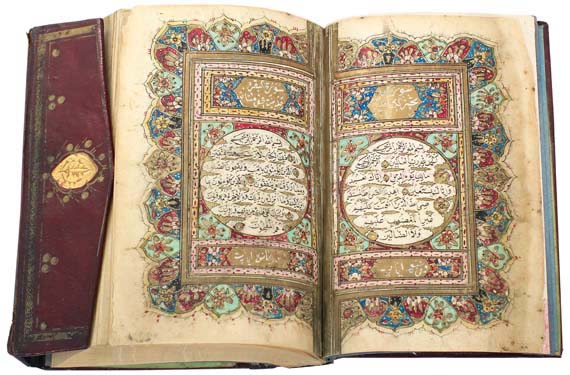 ‘Ottoman Qur’an’ / Turkey, dated AH1266 (1832 AD) / Courtesy of Ayyam Gallery
‘Ottoman Qur’an’ / Turkey, dated AH1266 (1832 AD) / Courtesy of Ayyam Gallery
Ottoman Qur’an dated AH 1289 (1855 AD). On paper’s first double pages are decorated in Mihrab designs in blue, pink and yellow with gilded verse markers. Written by scribe Nassouh Zahdah Taher Beik, who was a scholar of Bakara Mohamad Zadah, this Qur’an is enclosed with a leather binding decorated with a gilded double border with four scrolling spandrels that frame the central medallion.
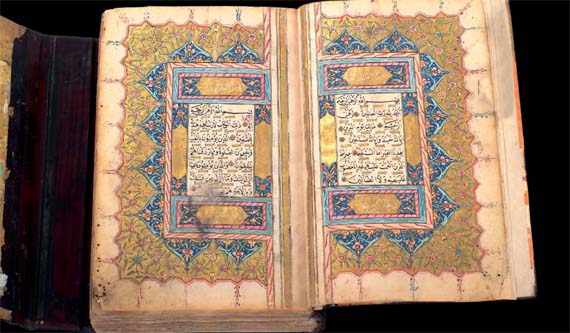 ‘Ottoman Qur’an’ dated AH 1289 (1855 AD) / Courtesy of Ayyam Gallery
‘Ottoman Qur’an’ dated AH 1289 (1855 AD) / Courtesy of Ayyam Gallery
Ottoman Qur’an, 314 Leaves. Turkey, 19th Century. Hand written in Nasikh script, the first double pages of this exquisite Qur’an were decorated with a scrolling foliage pattern that was designed by Mustafa Zuhdy Bayram Zada Ibn Hussein Helmy. This Qur’an is bound with a well-kept leather cover that is contoured with two golden scrawling spandrels and a central medallion.
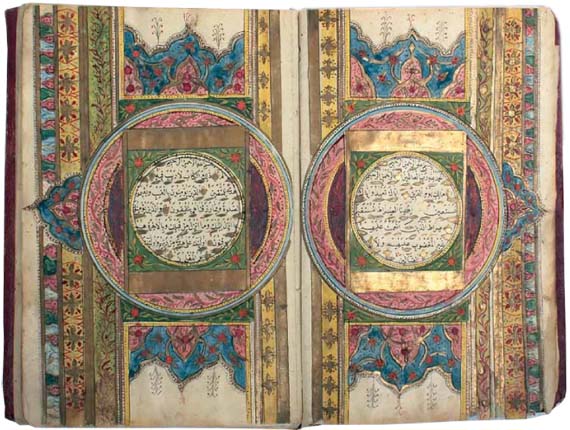 ‘Ottoman Qur’an’ / 314 Leaves. Turkey, 19th Century / Courtesy of Ayyam Gallery
‘Ottoman Qur’an’ / 314 Leaves. Turkey, 19th Century / Courtesy of Ayyam Gallery
A Lebanese metal-thread prayer rug that is in splendid condition maintains an equally impressive level of mastery with pink, yellow and gold pure silk weaving in the Zou’ style. Forming a depiction of a Mihrab with two minarets in the background, its main image also contains three golden lanterns that are suspended from the center and flanked by an intricate floral design.
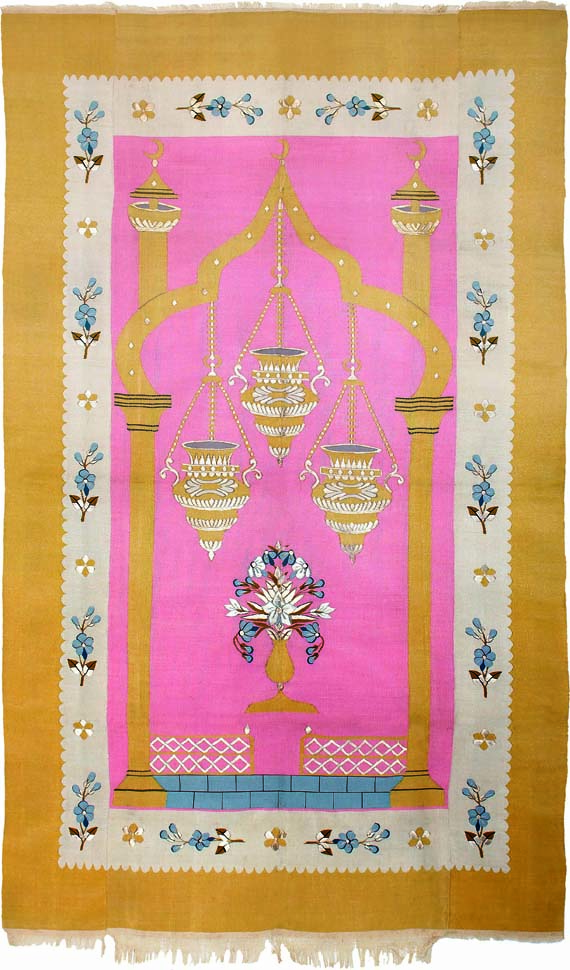 ‘Metal Thread Lebanese Silk Prayer Rug’ / H170 X W100 cm. Lebanon, 19th Century / Courtesy of Ayyam Gallery
‘Metal Thread Lebanese Silk Prayer Rug’ / H170 X W100 cm. Lebanon, 19th Century / Courtesy of Ayyam Gallery
A shimmering Georgian inspired estate bracelet catches the eye with 103 grams of 18-carat gold and 18-carats of Dutch rose cute diamonds that are only available in the fine antique market. With a 2.25-carat center stone, this over 20-carat piece is a remarkable testament to the opulent tastes of the Ottoman Empire.
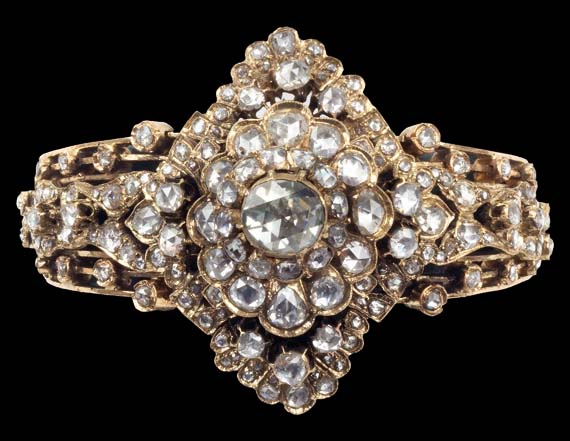 ‘Georgian Inspired Diamond Estate Bracelet’ / Courtesy of Ayyam Gallery
‘Georgian Inspired Diamond Estate Bracelet’ / Courtesy of Ayyam Gallery
Made of copper and glazed with floral and sky toned enameling, this Sarraf lantern is dome shaped with delicate filigree of scrolling foliage vines. Below the finial is inscribed ‘Al milkoo lillah’. It suspends from three chains that are decorated by enameled oval breaks. Six original glass candle cups protrude from the bottom separated by filigree. The canopy has been restored.
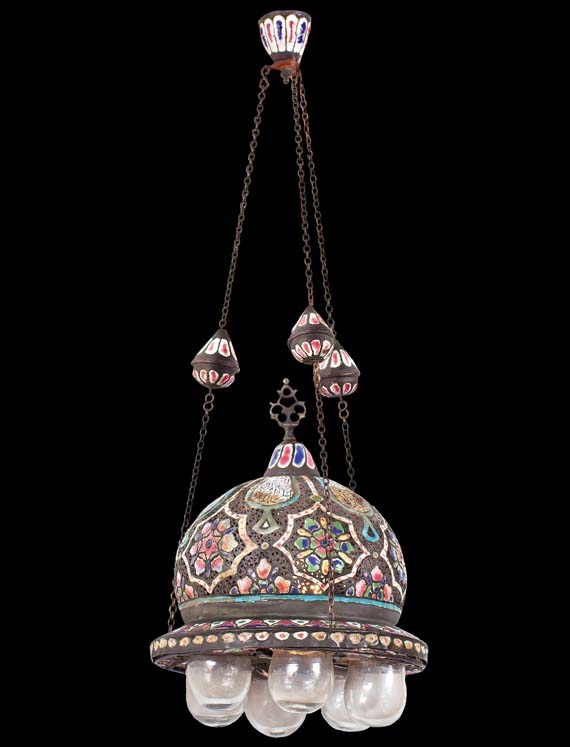 ‘Sarraf Lantern’ / Damascus, Late 19th century / Courtesy of Ayyam Gallery
‘Sarraf Lantern’ / Damascus, Late 19th century / Courtesy of Ayyam Gallery
An unusual late 1800s Damascene Kashkul, this unique object is made of copper with silver inlays and is decorated with scrolling foliate designs. Bearing the inscriptions “Innama al amaal bil niyat†and “Tafadalou ya sada†on both sides, it was made to hold incense burners and stands on four scrolling lizard-shaped feet that are intricately crafted and are interlaced with copper and silver.
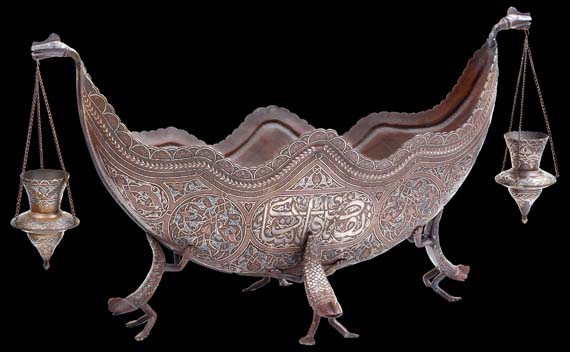 Mosque Kashkul / Damascus, late 19th century / Courtesy of Ayyam Gallery
Mosque Kashkul / Damascus, late 19th century / Courtesy of Ayyam Gallery
Of walnut, the elaborately decorated top of this stunning table sits on a single baluster column with a tee foil base. It possesses a central roundel with a scrolling foliage motif that is surrounded by concentric mother-of-pearl and tortoiseshell polygons. This is all bordered by scrolling medallion shaped sprawling cartouches. Standing on three bracket feet and supported by a hexagonal shaft, the table tips on its side for storage.
 Mother of Pearl and Tortoise Shell Folding Table / Turkey, early 19th century / Courtesy of Ayyam Gallery
Mother of Pearl and Tortoise Shell Folding Table / Turkey, early 19th century / Courtesy of Ayyam Gallery
Of shallow form with a raised rim, the panels are inscribed in silver in the Mamluk style. Around and in the center is engraved with a roundel in gold inscribed “Al malek al nasserâ€. The date in Arabic 1339 hijri is visible on both the rim and the back.
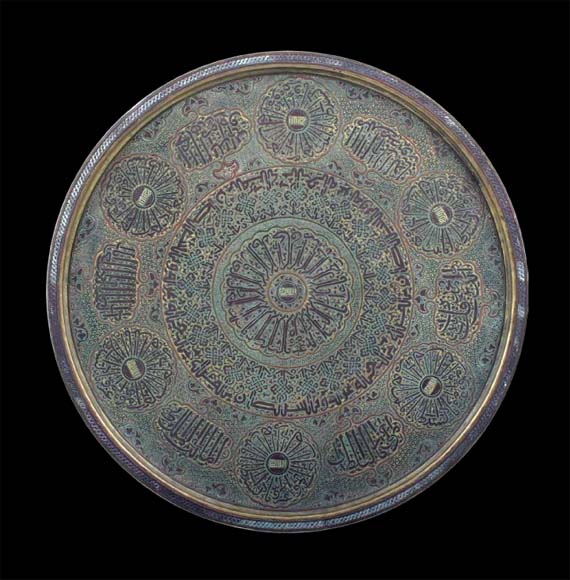 ‘Engraved Brass Tray’ / Damascus, early 20th century / Courtesy of Ayyam Gallery
‘Engraved Brass Tray’ / Damascus, early 20th century / Courtesy of Ayyam Gallery
Written in elegant Thuluth script by master calligrapher Hashem al Baghdadi, the text of this black ink on rice paper composition reads “Allah wali al toufic.”
 Calligraphic Composition / Iraq, early 20th century / Courtesy of Ayyam Gallery
Calligraphic Composition / Iraq, early 20th century / Courtesy of Ayyam Gallery
Of rectangular form, the sky blue satin of this duvet is delicately embellished with gold metallic thread. Consisting of cascading floral and foliage borders and a central medallion cartouche that is embedded with a large central flower, such items were handmade for sultans. Some wearing is visible on the satin.
 Metal Thread Embroidered Ottoman Satin Duvet / Turkey, mid 19th century / Courtesy of Ayyam Gallery
Metal Thread Embroidered Ottoman Satin Duvet / Turkey, mid 19th century / Courtesy of Ayyam Gallery
Comments
Add a comment